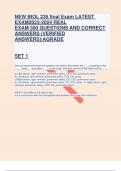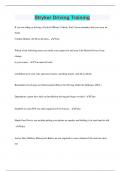Exam (elaborations)
NEW BIOL 235 final Exam LATEST EXAM REAL EXAM 300 QUESTIONS AND CORRECT ANSWERS (VERIFIED ANSWERS)|AGRADE
- Course
- Institution
NEW BIOL 235 final Exam LATEST EXAM REAL EXAM 300 QUESTIONS AND CORRECT ANSWERS (VERIFIED ANSWERS)|AGRADE SET 1 Venous blood returning from systemic circulation first enters the , proceeds to the , loses a
[Show more]





